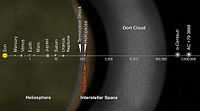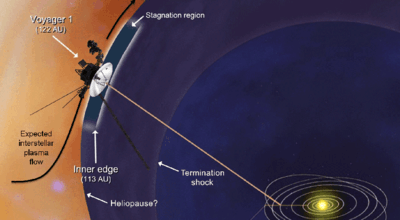Stars/Sun/Heliospheres
< Stars < Sun
"The heliosphere is a bubble in space "blown" into the interstellar medium (the hydrogen and helium gas that permeates the galaxy) by the solar wind. Although electrically neutral atoms from interstellar volume can penetrate this bubble, virtually all of the material in the heliosphere emanates from the Sun itself."[1]
Theoretical heliosphere
Def. the "region of space where interstellar medium is blown away by solar wind; the boundary, heliopause, is often considered the edge of the Solar System"[2] is called the heliosphere.
Termination shocks
"The point where the solar wind slows down is the termination shock".[1] Further out "is the heliosheath area ... As of June 2011, the heliosheath area is thought to be filled with magnetic bubbles (each about 1 AU wide), creating a "foamy zone".[3]"[1]
Electron winds
As of December 5, 2011, "Voyager 1 is about ... 18 billion kilometers ... from the [S]un [but] the direction of the magnetic field lines has not changed, indicating Voyager is still within the heliosphere ... the outward speed of the solar wind had diminished to zero in April 2010 ... inward pressure from interstellar space is compacting [the magnetic field] ... Voyager has detected a 100-fold increase in the intensity of high-energy electrons from elsewhere in the galaxy diffusing into our solar system from outside ... [while] the [solar] wind even blows back at us."[4]
Heliopauses
"[T]he point where the interstellar medium and solar wind pressures balance is called the heliopause".[1]
"[T]he point where the interstellar medium, traveling in the opposite direction, slows down as it collides with the heliosphere is the bow shock".[1]
"The outer edge of the solar system is the boundary between the flow of the solar wind and the interstellar medium. This boundary is known as the heliopause and is believed to be a fairly sharp transition of the order of 110 to 160 astronomical units from the sun. The interplanetary medium thus fills the roughly spherical volume contained within the heliopause."[5]
Interstellar medium

"The interstellar medium begins where the interplanetary medium of the Solar System ends. The solar wind slows to subsonic velocities at the termination shock, 90—100 astronomical units from the Sun. In the region beyond the termination shock, called the heliosheath, interstellar matter interacts with the solar wind. Voyager 1, the farthest human-made object from the Earth (after 1998[6]), crossed the termination shock December 16, 2004 and later entered interstellar space when it crossed the heliopause on August 25, 2012, providing the first direct probe of conditions in the ISM[7]."[8]
Research
Hypothesis:
- Each star has its own version of a heliosphere, perhaps called a stellasphere.
Control groups

The findings demonstrate a statistically systematic change from the status quo or the control group.
“In the design of experiments, treatments [or special properties or characteristics] are applied to [or observed in] experimental units in the treatment group(s).[9] In comparative experiments, members of the complementary group, the control group, receive either no treatment or a standard treatment.[10]"[11]
Proof of concept
Def. a “short and/or incomplete realization of a certain method or idea to demonstrate its feasibility"[12] is called a proof of concept.
Def. evidence that demonstrates that a concept is possible is called proof of concept.
The proof-of-concept structure consists of
- background,
- procedures,
- findings, and
- interpretation.[13]
See also
References
- 1 2 3 4 5 "Heliosphere, In: Wikipedia". San Francisco, California: Wikimedia Foundation, Inc. February 10, 2012. Retrieved 2012-02-10.
- ↑ "heliosphere, In: Wiktionary". San Francisco, California: Wikimedia Foundation, Inc. August 16, 2013. Retrieved 2013-10-01.
- ↑ NASA - A Big Surprise from the Edge of the Solar System (06.09.11)
- ↑ Steve Cole, Jia-Rui C. Cook, and Alan Buis (December 2011). "NASA's Voyager Hits New Region at Solar System Edge". Washington, DC: NASA. Retrieved 2012-02-09.
- ↑ "Interplanetary medium, In: Wikipedia". San Francisco, California: Wikimedia Foundation, Inc. March 14, 2013. Retrieved 2013-05-13.
- ↑ Voyager: Fast Facts
- ↑ Stone, E. C.; Cummings, A. C.; McDonald, F. B.; Heikkila, B. C.; Lal, N.; Webber, W. R. (2005). "Voyager 1 Explores the Termination Shock Region and the Heliosheath Beyond". Science 309 (5743): 2017. doi:10.1126/science.1117684. PMID 16179468.
- ↑ "Interstellar medium, In: Wikipedia". San Francisco, California: Wikimedia Foundation, Inc. April 17, 2013. Retrieved 2013-05-13.
- ↑ Klaus Hinkelmann, Oscar Kempthorne (2008). Design and Analysis of Experiments, Volume I: Introduction to Experimental Design (2nd ed.). Wiley. ISBN 978-0-471-72756-9. http://books.google.com/?id=T3wWj2kVYZgC&printsec=frontcover.
- ↑ R. A. Bailey (2008). Design of comparative experiments. Cambridge University Press. ISBN 978-0-521-68357-9. http://www.cambridge.org/uk/catalogue/catalogue.asp?isbn=9780521683579.
- ↑ "Treatment and control groups, In: Wikipedia". San Francisco, California: Wikimedia Foundation, Inc. May 18, 2012. Retrieved 2012-05-31.
- ↑ "proof of concept, In: Wiktionary". San Francisco, California: Wikimedia Foundation, Inc. November 10, 2012. Retrieved 2013-01-13.
- ↑ Ginger Lehrman and Ian B Hogue, Sarah Palmer, Cheryl Jennings, Celsa A Spina, Ann Wiegand, Alan L Landay, Robert W Coombs, Douglas D Richman, John W Mellors, John M Coffin, Ronald J Bosch, David M Margolis (August 13, 2005). "Depletion of latent HIV-1 infection in vivo: a proof-of-concept study". Lancet 366 (9485): 549-55. doi:10.1016/S0140-6736(05)67098-5. http://www.ncbi.nlm.nih.gov/pmc/articles/PMC1894952/. Retrieved 2012-05-09.
Further reading
- Steve Cole, Jia-Rui C. Cook, and Alan Buis (December 2011). "NASA's Voyager Hits New Region at Solar System Edge". Washington, DC: NASA. Retrieved 2012-02-09.
External links
- African Journals Online
- Bing Advanced search
- Google Books
- Google scholar Advanced Scholar Search
- International Astronomical Union
- JSTOR
- Lycos search
- NASA/IPAC Extragalactic Database - NED
- NASA's National Space Science Data Center
- NCBI All Databases Search
- NCBI Site Search
- Office of Scientific & Technical Information
- PsycNET
- PubChem Public Chemical Database
- Questia - The Online Library of Books and Journals
- SAGE journals online
- The SAO/NASA Astrophysics Data System
- Scirus for scientific information only advanced search
- SDSS Quick Look tool: SkyServer
- SIMBAD Astronomical Database
- SIMBAD Web interface, Harvard alternate
- Spacecraft Query at NASA.
- SpringerLink
- Taylor & Francis Online
- Universal coordinate converter
- WikiDoc The Living Textbook of Medicine
- Wiley Online Library Advanced Search
- Yahoo Advanced Web Search
| ||||||||||||||||||||||||||||||||
![]() This is a research project at http://en.wikiversity.org
This is a research project at http://en.wikiversity.org
| |
Development status: this resource is experimental in nature. |
| |
Educational level: this is a research resource. |
| |
Resource type: this resource is an article. |
| |
Resource type: this resource contains a lecture or lecture notes. |
| |
Subject classification: this is an astronomy resource. |